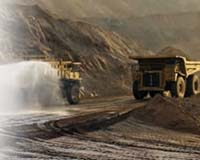| . |  |
. |
Cwmgwrach, Wales (AFP) Feb 26, 2007 With lights twinkling brightly from their helmets, a group of miners emerge caked in dust from a deep coal-mine in the village of Cwmgwrach in south Wales. The reopening of Cwmgwrach (pronounced Kumrak) marks a much-needed glimmer of hope for Britain's mining sector, which has been blighted by social and economic problems since the 1980s. After 60 years of decline, the industry has been shaken up by technology which has slashed energy wasted in the coal-mining process -- while also cutting carbon dioxide emmissions. The Cwmgwrach facility -- set to restart production this year -- will be the first opening of a deep mine for around 30 years. "It's good to be back," said miner Tony Berg after clambering out of the mineshaft. He added: "It is hard work, but you work together. The spirit is what you miss when you're doing another job." With a growing global consensus emerging over the catastrophic threat of global warming, coal mining has witnessed something of a renaissance. Added to the picture, rising coal prices and rampant Chinese demand -- alongside dwindling British gas and oil reserves in the North Sea -- have sparked new interest in coal. "The future looks brighter for coal than it has for at least two decades," said Iain McMenemy, a spokesman for Scottish Coal. "Demand has increased in the UK -- coal now produces about 50 percent of our electricity, up from 30 percent a few years ago." In Britain, there are only seven coal deep-mines still in operation, according to the Department for Trade and Industry. Roughly one third of the country's electricity was produced by coal in 2005. But that figure rose to as much as 50 percent during the past two winters owing to higher gas prices and colder weather conditions. Back at the Cwmgwrach plant, experts estimate that some 89 million tonnes of coal remain. Production is expected to begin later this year, with annual production of 1.0 million tonnes expected from 2008 onwards. The mine was closed in 1999 due to lack of profitability. "When you look at the old mining methods, they wasted a lot," said Steve Turtain, systems manager at Cwmgwrach. "Now the energy which is produced from the coal is very clean, with not much waste." He added that the new mine would bring also more money into the Welsh village and thus benefit the whole community. "It's going to bring in higher paid jobs and we'll create a new community spirit," Turtain said. "We want to be the leading force for technology again, for mining equipment, and that again will help the local industry. We want to build a family of miners as it was towards the end of the seventies." The mining sector was ravaged in the mid-1980s. Coal miners striking against pit closures were crushed in 1985 after a bitter struggle with the Conservative government of former prime minister Margaret Thatcher. The current British government, meanwhile, was dealt an embarrassing blow last week over plans to expand the country's nuclear power facilities. The High Court in London ruled that a government decision last year to approve plans for new nuclear power plants was illegal because public consultations were flawed. Advocates of new nuclear reactors -- which emit virtually no carbon dioxide -- argue they would help Britain meet its pledge to reduce greenhouse gas emissions by 20 percent of 1990 levels by 2010. Britain has about a dozen nuclear power stations, most of them built in the 1960s and 1970s, providing about 25 percent of the country's electricity, compared with natural gas which provides about 40 percent.
Source: Agence France-Presse
Related Links  Oak Ridge, TN (UPI) Dec 15, 2006
Oak Ridge, TN (UPI) Dec 15, 2006 A better understanding of natural and alternative methods of cleaning contaminated sites is the goal of an Oak Ridge (Tenn.) National Laboratory project. Researchers from ORNL said they hope to develop models that will help predict the rate at which contamination levels drop when using natural methods such as bioremediation -- stimulating bacterial growth in the subsurface for cleanup -- and artificial techniques such as chemical additions and pH adjustments. |
|
| The content herein, unless otherwise known to be public domain, are Copyright 1995-2006 - SpaceDaily.AFP and UPI Wire Stories are copyright Agence France-Presse and United Press International. ESA PortalReports are copyright European Space Agency. All NASA sourced material is public domain. Additionalcopyrights may apply in whole or part to other bona fide parties. Advertising does not imply endorsement,agreement or approval of any opinions, statements or information provided by SpaceDaily on any Web page published or hosted by SpaceDaily. Privacy Statement |